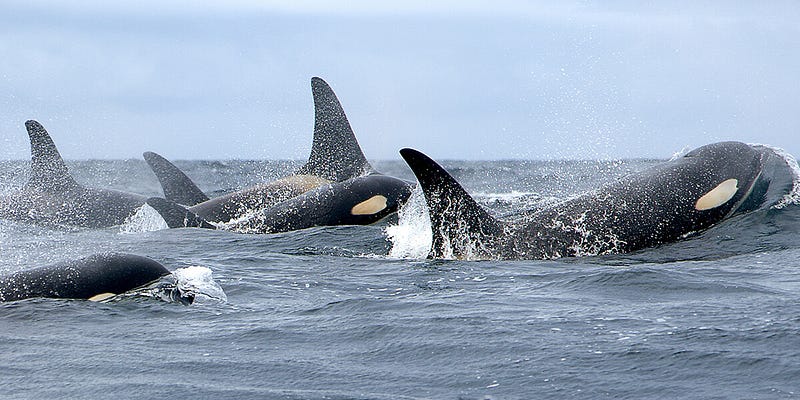
Save the Southern Residents
Grieving orca carrying dead calf highlights slide toward extinction
The
slide toward extinction of endangered West Coast killer whales has
captured public and media attention this summer. We grieved with orca mother Tahlequah
as she carried her dead calf for 17 days and 1,000 miles. The feat kept
her from eating and cost her precious energy. Just a quarter of her
pod’s newborns have survived in the past two decades.
It’s
been hard not to identify with the plight of the Southern Resident
killer whales. Their population is down to just 75 and failing right
before our eyes. They are wild animals, but their obvious grief and pain
seem relatable to most of us. Killer whales are indeed intelligent,
social animals known to form lasting social bonds — living in highly
organized pods where everyone cares for the young, sick, or injured.
Despite
our love for these iconic orcas, human activities are what’s driving
the Southern Residents toward extinction — and only humans and the
overdue actions that we should be taking are going to save them. It’s on
us.
Southern
Residents are starving because we’ve depleted the salmon runs they rely
on by damming their rivers, logging, and developing the surrounding
habitat. Their health is compromised by the toxic chemicals and other
pollutants we’ve subjected them to over their long lives. As they travel
along the West Coast from Canada to the San Francisco Bay, they get
harassed and disturbed by shipping traffic, military sonar and other
human activities.
So
it’s no wonder that Tahlequah, also known by scientists as J35, gave
birth to a baby that could not survive long. This population hasn’t
successfully reproduced since 2015, a direct result of the stresses they
experience from myriad human causes.
But we can still help turn things around. Washington state residents love and celebrate these iconic orcas, from the everyday “orcaholics” who follow their movements or build them monuments in Seattle to the experienced researchers who provide them comfort and aid.
A starving, emaciated orca
named Scarlet, aka J50, might already be dead by now if it wasn’t for
the scientists and tribes who secured a supply of live chinook
salmon — the Southern Residents’ favorite food — and came up with
ingenious ways to deliver antibiotics and other medicines that might
help.
Yet,
such individualized care won’t save this critically endangered species.
Southern Residents need robust and bold actions on a big scale if these
magnificent orcas are going to survive. Notably, the goal of the
Endangered Species Act is to recover these magnificent animals. It has
powerful tools to protect habitat, limit threats, and plan the recovery
of endangered species.
A recent study
of the success of the Endangered Species Act found that 78 percent of
marine mammals and sea turtles protected by the Act have populations
that are significantly increasing. But the Endangered Species Act only
works if the feds robustly use its tools.
Instead,
we’ve seen the Trump administration and Congress attempt to dismantle
this landmark environmental law rather than use it to save our orcas.
Congressional Republicans have launched more than 75 legislative attacks
that would block or weaken protections for endangered species, and the
Trump administration has proposed regulatory changes that chip away
protections.
For
orcas, it is the feds’ woeful inaction that is undermining their
recovery. For example, in 2015 the National Marine Fisheries Service
concluded that habitat protections needed to be expanded to protect the
winter foraging areas for Southern Resident killer whales — but to date,
the feds have failed propose any new critical habitat protections.
Expanding
habitat protections to include the coastal waters off Washington,
Oregon and California would safeguard the killer whales’ winter foraging
areas. Scientists have noted that it’s during the winter that the orcas
are especially starving. Designating these areas as critical habitat
will trigger a requirement that any federally permitted activity must
avoid harming the habitat. This could mean reducing water pollution,
noise pollution, vessel disturbance, and protecting prey. Endangered
species with critical habitat are twice as likely to be recovering than those without it.
Acknowledging
that these iconic orcas are dying and that they need and deserve basic
habitat protections is the very least we can do. It’s the first step
toward saving them.
Miyoko Sakashita directs the oceans program at the Center for Biological Diversity, which filed a lawsuit on August 16 to compel the Trump administration to expand habitat protections for Southern Resident killer whales.





